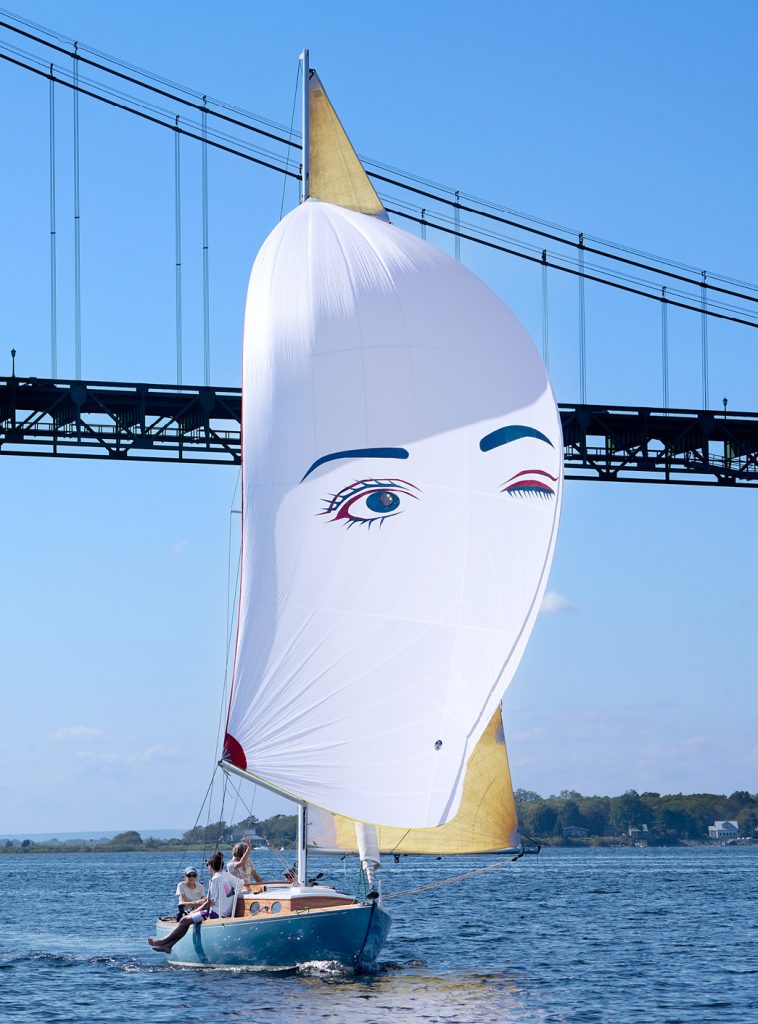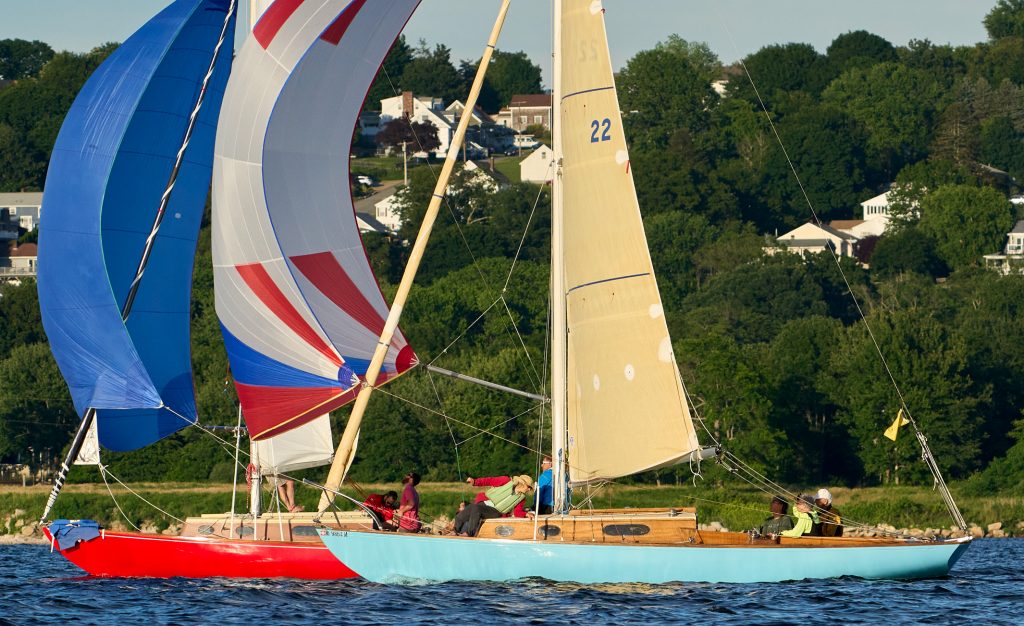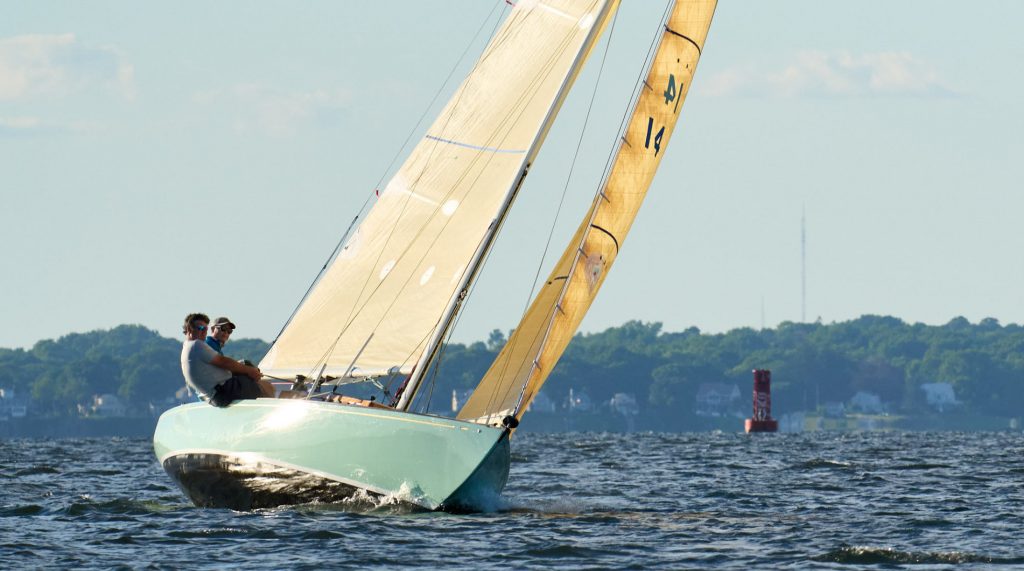Story & photos by Greg Anthony
We had just crossed the finish line. As I rounded the boat up for the 5-mile beat home, the elation of saving our time on “Z” and flat out finishing ahead of all our other fleet members turned to dread. It would be dark in 15 minutes, it was blowing 15, and the Mt. Hope Bridge, 4.5 miles to windward, was disappearing in the approaching fog bank. Lights on the bridge were just a glow on the horizon. Soon the bridge would disappear. The fog brought cool, almost cold temps for a Wednesday night in late August, and Wink was heeling hard with the pull of her 135% genoa and the Velocitek reading 6.5 knots. I figured it would be three tacks to get under the main span. On the other side lay the real problems: Musselbed Shoals to port on the Portsmouth side and the (Pardee’s nun) Bristol Point Rock buoy to starboard. If we made it by those…
Under my breath I muttered, “You jackass.” In my haste to get our newly restored sloop in the water before the end of the 2021 season, I had neglected rewiring the running lights. Back in late July I had told myself, “We’re only going to daysail her this year. We’ll take care of that next winter.” It was never my intention to put close friends and crew Chis, Dave and my wife in this type of situation.
As we approached the bridge just 25 yards away, the glow revealed one of the two main stanchions, but on the far side was a complete blackout with much denser fog than had made its way into Mt. Hope Bay before. Struggling to see and sailing by our chart plotter app, I barely had time to think about the past year; about how the pandemic had created an improbable opportunity in our lives. When I had daydreamed about boat ownership and returning to Bristol, this was not the story I had been telling myself.
Back in April 2020, pandemic in full swing, we sequestered from Boston to our summer cottage in Bristol, RI. After performing all the outdoor landscaping that I could stand, I found myself becoming quite bored by the middle of May. As the weather was getting warmer, I launched our hard bottom center console inflatable Jack Rabbit. I started taking motorboat rides in the mornings while it was still calm. It was a short ride from our house on Poppasquash to the Barrington River, where I decided to do some in-the-water boat shopping. Just feeding my fancy.
Well, no surprise, in Barrington there was the usual collection of modern plastic fantastic racer/cruisers, some being quite heinous with loads of freeboard and windows in the topsides, more resembling aircraft carriers than sailboats. As for boats I’d like to be seen on or struck my eye, they were few and far between. On my way back down river I passed a striking 30-foot sloop with a person in the cockpit. With time on my hands, I decided to take a closer look. She was a handsome craft with pleasing sheer and not too much freeboard.

Following an eight-month restoration (including the removal of 1,200 pounds of “extra” ballast comprising cement with hundreds of lead tire balancing weights mixed in!), Wink looks alluring on Mt. Hope Bay.
I complemented the guy, telling him he had one of the most attractive boats in the river. As I circled October, we engaged in conversation and he informed me she was a Graves Constellation. After a few more words it became apparent that this fellow was a beloved family friend, Colby Smith, who I hadn’t seen in over thirty years. Long story short, a week later my wife Julie and I found ourselves sailing with Colby on October over in Mt. Hope Bay where she’s moored. It was classic 10 to 15 knots of breeze, flat water and October was lively and steered like a dream. During our sail, Colby referred to the Constellation as a poor man’s Herreshoff S boat. I fell in love.
There were twenty-seven Graves Constellations built by the Graves Yacht Yard in Marblehead between 1964 and 1971. Selman Graves is credited with her design but, as rumor has it, with help from neighbor and friend L Francis Herreshoff. They’re a fractional rig, 29.5 feet LOA, 20.25 feet LWL 8 feet beam with an old school solid 1+ in. fiberglass hull (no pesky core) and mahogany coachroof. In my opinion, an object of beauty.
In a corner of Narragansett Bay lies Mount Hope Bay. Bordered by Massachusetts with Fall River at the head, then Rhode Island’s Tiverton and Portsmouth with Warren and Bristol on the opposite shore, and the Mt. Hope Bridge at the entrance. Despite growing up on Bristol Ferry, the peninsula with the Mt. Hope Bridge, I rarely ventured into Mount Hope Bay unless it was to attend one of the Narragansett Bay Yachting Association regattas hosted by the Coles River and Tiverton Yacht Clubs. In my undeserved snobby, elitist youth, I affectionately referred to it as the West Virginia of Narragansett Bay, as this area is a bit more provincial than fashionable Newport. As it turns out, there is a burgeoning fleet of six Constellations in West Virginia that actively compete in SIRA (Spar Island Racing Association) races on Wednesday nights and Saturdays in the spring and fall. In fact, there are a total of ten Constellations in the Bay as a whole!
Further investigation revealed that this fleet is quite diverse. At its core are Dave Pritchard and his wife Andy, who purchased their Constellation, Andromeda (hull #22) new back in the 1960s. Dave is a renowned MIT professor of Physics with a summer house just inside the Sakonnet River. Just the nicest couple you’d ever meet, although after speaking with Dave for a while you realize what a great intellect he has.
Then there is Colby Smith, former boat builder, now sculptor/craftsman. He purchased October as a wreck, solid hull but no deck or cabin house; just a hull, mast and sundry parts stored in the gaping hull, which he lovingly rebuilt. At the soul of the fleet are Bob Buffinton and son Pete with Satori (hull #27). Bob is a lobsterman, always smiling, with a wry sense of humor and a laugh that is contagious. Pete is a graduate of the IYRS School of Technology & Trades in Newport, specializing in composites, and worked with the New York Yacht Club American Magic team. Together they have a can-do spirit and are great fun to hang with. If I were to put out to sea, these are the guys I’d want to go with.
Then there is “Z,” Mike Zani with Vela (hull #14). Z is a four time collegiate All-American sailor from Brown University. He has brought sailing luminaries Ken Read and Moose McClintock along as crew. This ups everyone’s game. Mike is always available to help and make suggestions when one is in need. He treats all Constellation owners with respect, but make no mistake. He lets you know what he wants when it comes to fleet direction and PHRF ratings. He is the driving force for having our own Constellation Class start in the PHRF-dominated SIRA. Other fleet members include Ken Yeager with Mira. Ken had back surgery this summer and was absent for most of this season, but we look forward to his return in 2022. Erik Ekwall rounds out the group with Azura. Erik is by far the most handsome, GQ quality and super-friendly. He unfortunately installed a sail drive in his yacht, so the fleet has made an allowance for him to remain competitive. In spite of the fleet’s diversity, it appears you can’t take the Graves out of the Graves, no matter the alterations one might have made. As shown in the first three Wednesday nights of this 2021 season there were three different winners. Who doesn’t love that?

The racing’s always close in the Mt. Hope Bay Constellation fleet. Here, Andy & Dave Pritchard’s Andromeda (#22) dices with Bob and Pete Buffinton’s Satori.

Pictured at the helm of Vela, Mike “Z” Zani led the charge to include Constellation Class starts in Spar Island Racing Association events.
Back to our journey of discovery. Like hounds on the scent, Julie and I began our search for a Constellation of our own in June, 2020. With so few built, it soon became apparent they were hard to come by. In early August I finally found one in Hayes, VA, a backwater in the lower Chesapeake Bay near Yorktown. Unfortunately being a pushy Yankee, the owner refused to sell it to me. Can you believe it? So with the help of a close and much more diplomatic friend, Henry Filter, who lives on the eastern shore of the Chesapeake, I was able to purchase Pegasus, as she was called then. In a turnaround, Henry resold her to yours truly. We had her shipped to Bristol and renamed her Wink, with her dinghy named Nod.
Over in Mt. Hope Bay, it became apparent that there was a bit of an arms race in the Graves fleet, so there was much to be done in order to make Wink competitive. We looked to friends PJ Schaffer, Lars Guck and Will Welles to help us. PJ, Engineer and Project Manager at Safe Harbor New England Boatworks, redesigned the rig and deck layout. Lars, of Guck Inc, agreed to fair the bottom and strip the original bronze hardware and winches off the deck and install modern hardware per PJ’s design. While removing the old fittings, Lars discovered the deck installed by the previous owner was built of particleboard covered with ugly rubber non-skid Kiwi Grip.
We all know what happens to particleboard when exposed to water and thus the project expanded. Next, Lars and I decided to inspect the bilge, which had been sealed off under a teak and holly cabin sole. According to the original plans for the boat, the lead was in the front third of the keel sump with the rest of the sump, a 5-foot deep hollow. The previous owner must have felt she was a little too tender and to our amazement we discovered that he had filled the balance of the sump with cement. To that cement he had added hundreds of small lead weights used in automotive tire balancing. This combination of cement and lead added over 1,200 pounds to her weight. None of this was apparent to the surveyor when we had the boat inspected before purchase. Yikes!
After days of unsuccessfully working with an electric impact hammer, we ended up hiring a landscaper with a jackhammer to go below to start breaking up the cement. However, the throw on the jackhammer chisel is only about eighteen inches and we needed to go five feet, so we ended up drilling holes in the side of the keel to get the jackhammer in to break up the cement we couldn’t reach from the top. At this point, the project could safely be called “epic”. Only after the giant holes in the side of the keel were patched was Lars able to fair the bottom.
Will, who works for North Sails, provided our new rags and they’re beautifully efficient. Bristol is a wonderful place to have your boat worked on; pretty much one-stop shopping. Finally by mid-July – after eight full months of work – the mighty Wink was ready to splash. Julie and I now race her with a combination of crew including PJ Schaffer, Chris Hufstader, former Senior Editor of Sailing World, Dave Franzel, founder of the Boston Sailing Center and St. Thomas Sailing Center, and 26-year-old son Ben.
In the meantime, Mike Zani in his zeal to add more Constellations to our fleet had located and purchased a second Constellation, which is now for sale. The one caveat is that she must race in the seven-boat Graves fleet in Mount Hope Bay. A small price to pay.
Thanks to our chart plotter app we were able to get a visual on nun “2,” the Bristol Point Rock buoy, which appeared when only ten feet to starboard. We finally felt a bit more secure. We proceeded to short tack the east side of the Bristol Ferry shore, narrowly missing the Howe dock and its swimming float, and made our mooring which lay thirty yards to the north. Another successful but stressful Wednesday night racing in SIRA.
Living back on the Narragansett Bay side of Bristol Ferry, where I grew up, is all I ever wanted. But it is in West Virginia (aka Mount Hope Bay) where we found our home. Julie and I are now living the dream with our object of beauty, sailing and racing the Wink, a Graves Constellation. ■




